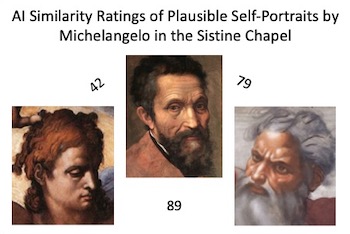
Three of the faces in Michelangelos Sistine Chapel frescos are recognized as portraits: his own sardonic self-portrait in the flayed skin held by St Bartholomew, itself a portrait of the scathing satirist Pietro Agostino, and the depiction of Mary as a portrait of his spiritual soulmate Vittoria Colonna. The first analysis was of the faces of the depictions of God and of the patriarch Jacob, which were rated by AI-based facial ratings as highly similar to each other and to a portrait of Michelangelo. A second set of young faces: Jesus, Adam and Sebastian, were also rated as highly similar to God and to each other. These ratings suggest that Michelangelo depicted himself as all these central figures in the Sistine Chapel frescoes. Similar ratings of several young women across the ceiling suggested that they were further portraits of Vittoria Colonna, and that she had posed for Michelangelo as a model for the Sistine Chapel personages in her younger years.

The accuracy of face recognition systems is significantly affected by the quality of face sample images. There are many existing no-reference image quality metrics (IQMs) that are able to assess natural image quality by taking into account similar image-based quality attributes. Previous study showed that IQMs can assess face sample quality according to the biometric system performance. In addition, re-training an IQM can improve its performance for face biometric images. However, only one database was used in the previous study, and it contains only image-based distortions. In this paper, we propose to extend the previous study by use multiple face database including FERET color face database, and apply multiple setups for the re-training process in order to investigate how the re-training process affect the performance of no-reference image quality metric for face biometric images. The experimental results show that the performance of the appropriate IQM can be improved for multiple databases, and different re-training setups can influence the IQM’s performance.

In this paper, we propose a face pose normalization and simulation methods based on multi-view face alignment that can enhance the performance of the face recognition algorithm towards large pose variation. The proposed method includes two steps: 1) multi-view face alignment, 2) face pose normalization and simulation methods. Multi-view face alignment algorithm is inspired by the design idea of the Supervised Descent Method (SDM) which is considered the state-of-the-art in face alignment. The proposed method modified the algorithm to adapt multi-view problems by changing the histogram of gradient feature to projection of gradient feature in order to adapt large pose variance. In addition, the feature scale also can be adaptive adjusted towards different part of face, for example, eyes, mouth, eyebrows, etc. Based on the multi-view face alignment results, 2D face normalization and simulation methods are proposed. Experimental results over many images with obvious pose changes have shown our method can significantly normalize the multi-view pose face and improve the accuracy of the existing common face recognition method when faces of probe sets have large pose variation.